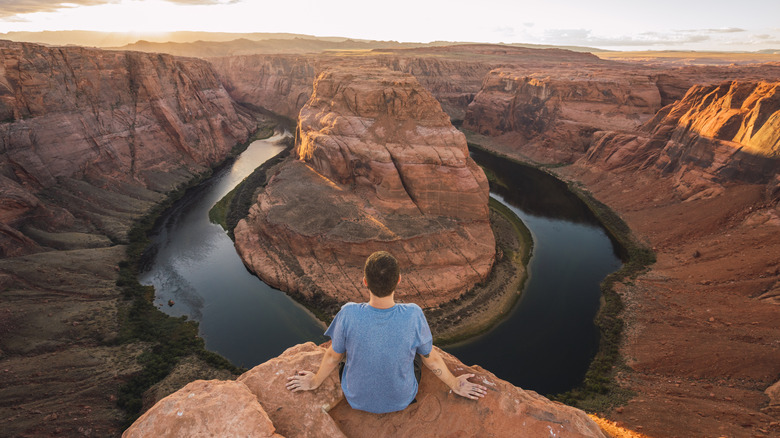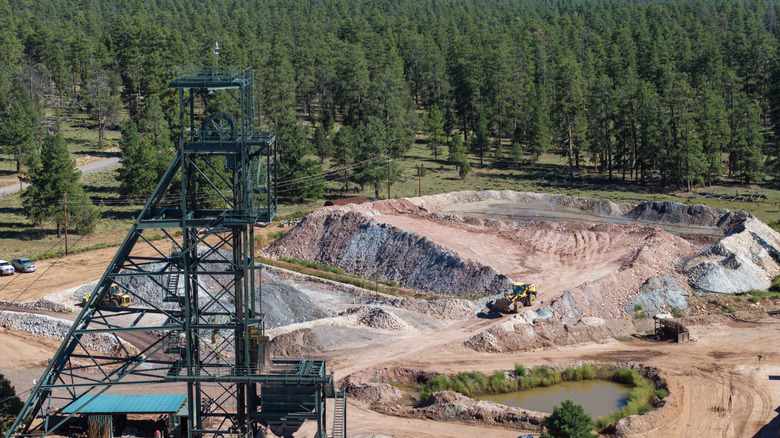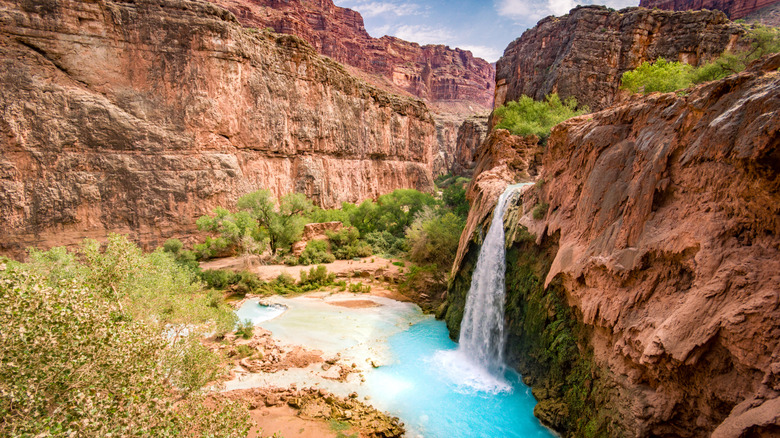A Radioactive Element Could Pose A Great Threat To The Grand Canyon As We Know It
Every year, around 5 million people visit the world's largest canyon to take in its natural splendor. Grand Canyon National Park is home to an abundance of wildlife, including bighorn sheep, the California condor, elk, and a wide diversity of desert plants. But the biggest attraction is the canyon itself. Besides its breathtaking natural beauty, the mile-deep gorge reveals nearly 2 billion years of rock layers, showing a timeline of Earth's geological history. Even today, the Colorado River and its tributaries continue to erode the ancient rocks along the base of the canyon. Now, however, uranium mines threaten to contaminate the delicate balance in the region.
Ever since uranium mining in the Grand Canyon region began in the 1950s, it has been fraught with controversy. Environmentalist and social justice groups have fought together to protect the land from development, citing concerns about the possibility of radioactive contamination of the ecosystem. Mining also defies indigenous rights to the land, since at least 11 Native American tribes have ancestral ties to the region. A recent scientific study has provided data to suggest the activists' concerns are warranted. It appears that uranium-contaminated water in the Grand Canyon has a broader reach than anticipated.
In a 2024 collaborative paper from the University of New Mexico, researchers examined the ways that groundwater flows through fault paths within the geological layers of the Grand Canyon region. Their data reveal that the extent and complexity of these underground water networks had been underestimated, as contaminated water from the uranium mines can make its way to the above-ground springs that the local wildlife and native inhabitants rely on. The finding substantiates the activists' claims, but it nonetheless predicts a devastating future for the Grand Canyon if protective regulations aren't enforced to stop the spread of mining.
The politics that allow one uranium mine to operate in sacred land
Various uranium mines have operated in the Grand Canyon region through the decades. In 2023, however, a 900,000-acre area surrounding Grand Canyon National Park was officially recognized as a national monument, thus protecting the region from development and mining operations. This designation — called the Ancestral Footprints of the Grand Canyon National Monument — was positive news for environmentalist and indigenous activist groups. But to the frustration of the local Havasupai Tribe, one mine in the national monument remains in operation: the Pinyon Plain uranium mine. Even though the Pinyon Plain Mine commenced operations after the national monument was established, its mining permit was granted in 2012, which meant its operational rights were "grandfathered in."
The Pinyon Plain Mine is in a contentious location. Not only is it situated above veins of high-grade uranium, but it's also on ground sacred to the Havasupai Tribe. Worse yet, just a few layers of rock separate the mine from the massive underground aquifer that supplies many of the once-sacred springs in the area. While this close proximity raised alarms with activist groups, the Arizona Department of Environmental Quality (ADEQ) granted permission to commence mining on the assumption that the aquifer and the uranium extraction were separated by "thick layers of low-permeability rock." The ADEQ's technical reports also conclude that the mine site was free of fault paths that could connect to the waterways through the supposedly solid rock layers. Unfortunately, new surveys suggest quite the opposite.
How uranium-contaminated groundwater can make its way to the surface
Based on new data, it appears that the ADEQ's technical reports failed to recognize the interconnectedness of underground aquifers. Most uranium mines are open-pit mines, but the ones in the Grand Canyon region are "breccia pipe mines." Essentially, breccia pipes are deep caverns that pass vertically down through multiple layers of rocks and are filled with crushed sedimentary rocks. Compared to the solid rock layers surrounding them, breccia pipes are easier to drill through — but they also may be easier for groundwater to penetrate.
The 2024 study, titled "Hydrotectonics of Grand Canyon Groundwater," states that it's "highly likely" that contamination from the Pinyon Plain Mine can travel via vertical pathways in breccia pipes between aquifers, eventually making its way to springs on the surface. For example, one of the study's findings points to the case study of the Orphan Mine. Located on the south rim within Grand Canyon National Park, the Orphan Mine has been inactive for over half a century. However, several surveys link the inactive mine to continued uranium contamination in springs located below the rim, suggesting uranium contamination can travel via unforeseen connections.
In the case of the Pinyon Plain Mine, the researchers discovered ways that contaminated water could travel both vertically and horizontally. By comparing isotopic signatures of different monitoring wells in the area, the team concluded that the aquifer below the Pinyon Plain Mine and the aquifer connected to the sacred springs of the Havasupai Tribe are, in fact, hydrologically connected. The paper's authors conclude that the solution is to cease operation "of all uranium mining activities at Pinyon Plain Mine," echoing the same demand that indigenous activists have been calling for since uranium was first mined in the Grand Canyon over 70 years ago.


